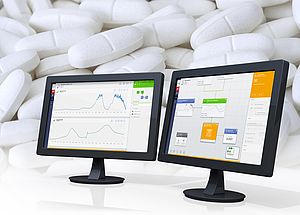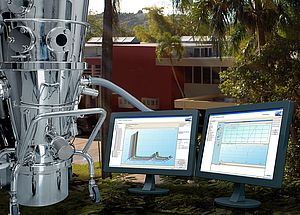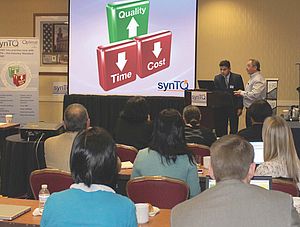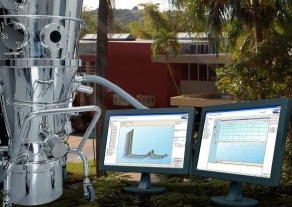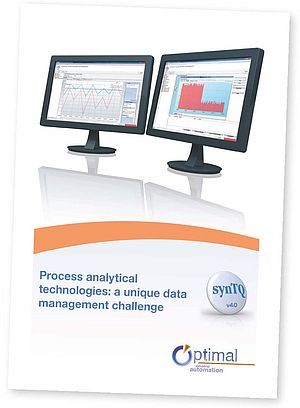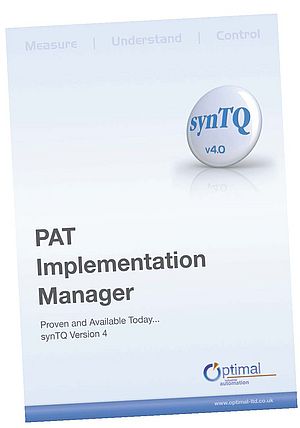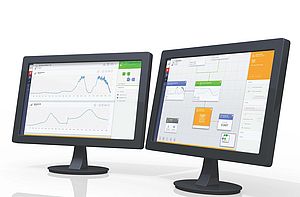The custom high speed vision system for a major pharmaceutical manufacturer presented immense challenges. Lighting techniques and specialised software technology enable the required image analysis to occur in a real time, and produce the desired responses.
The vision system needs to inspect seven key visual parameters relating to sealed blister packs at two per second. The packs are for the Japanese market, have Japanese text, and must have both sides 100% inspected. The challenge is compounded, due to the natural (but acceptable) variation in the blister packs, and the fact that they are made from aluminium foil, which is highly reflective.
Optimal Industrial Automation undertook the high speed inspection project after the pharmaceutical manufacturer had investigated buying a system from a standard supplier, but none was available. "The client's requirements were daunting," said Martin Gadsby, a Director of Optimal. "He needed to inspect to a standard that was higher than anywhere else: in effect, a zero tolerance standard. In addition, the speed of the line and the very small visual differences between the required standard and those that had to be rejected, were major issues that had not been addressed before in the industry. These factors, together with the aforementioned problem of a highly reflective product, made the project very challenging indeed, and were presumably why other vision inspection companies had declined to take it on."
The specification for the vision inspection system called for seven quality factors to be inspected. These were: Correct lot code and expiry date; correct overprint with no defects; and verification that there were 1) no scratches, 2) no dents, 3) no marks, 4) no holes, and 5), no surface contamination of any kind on the blister pack.
The importance of the overprint was of paramount: it is in Japanese characters and the system has to inspect it as such. Without an effective inspection system to perform this function, the production process would have been at best inefficient; at worst, the company would not have been able to export the product to Japan.
The task of providing a vision system to meet the customer's requirements involved developing a detailed understanding of the production process and the product itself, and then producing a technology leap in both hardware and software to achieve success. As with most vision inspection systems the lighting was critical. Optimal undertook a significant research and development programme where it developed a range of lighting techniques that had to be used in a specific sequence in order to provide the desired effects, whilst not being affected to too great an extent by the natural variations that occur in the blister packs.
In addition to lighting techniques, Optimal also developed specialised software technology that would enable the required image analysis to occur in a real time, and produce the desired responses despite the natural and acceptable variation in the blister packs. In combination with the lighting techniques and its regulatory compliant operator interface software for machine vision - synTI®, the specialist software is able to produce excellent and robust results that is also easy for the operators to use.
Therefore, after much development, Optimal has produced a system that integrates high speed digital cameras, lighting, image analysis techniques and a software package that identifies sub-standard packs correctly, so as to trigger their rejection from the production line.
"The fact that the blister packs reflect light made the acquisition of useful images very difficult, and also increased the difficulty of being able to see the desired surface defects to the required resolution," said Martin Gadsby. "Also, the blister pockets naturally move in each blister: not a huge amount, but sufficient to make a simple direct image comparison invalid. To overcome these problems, multiple images using differing lighting techniques were found to be necessary, all of these having to be correctly synchronised to each blister pack.
Having developed the system we then tested it extensively. Unfortunately, accurate detection of the blisters still proved to be a problem, because if they are not detected entering the system at exactly the correct time, then the timing of the process is thrown out. We trialled several sensing techniques before settling on one that addressed this problem.
Then, once the lighting was optimised and the timing of the products passing through the system was made robust, the image analysis was optimised by developing the image analysis algorithms in the high level software. The final system was then tested against product directly coming from the production line, to ensure that all of the naturally occurring variations had been catered for. Once this was achieved, the system was formally validated and passed for production purposes. It is now in daily operation and we are looking to build upon its success by talking to other customers that are interested in the technology."






